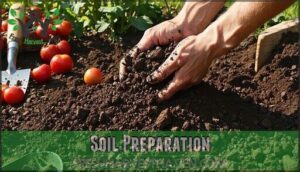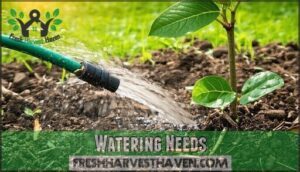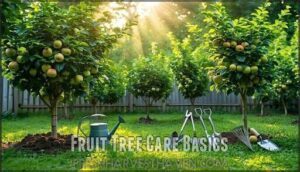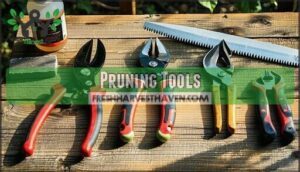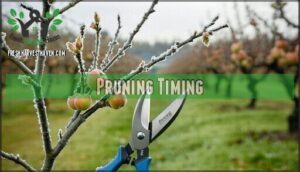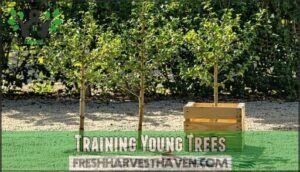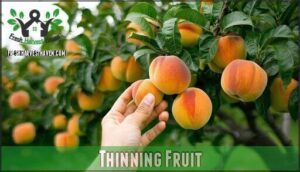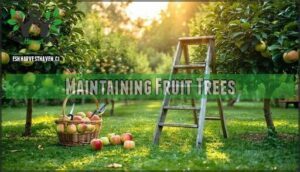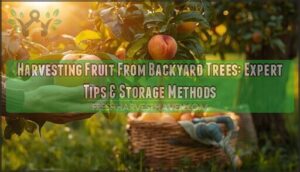This site is supported by our readers. We may earn a commission, at no cost to you, if you purchase through links.
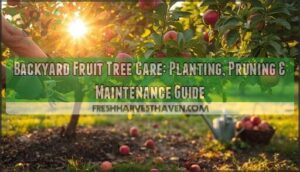
Once established, your trees need consistent watering, annual fertilization, and strategic pruning to maintain their shape and encourage healthy fruit production. Regular monitoring helps you catch pests and diseases early, while seasonal tasks like thinning fruit and adding organic matter keep trees vigorous.
Once you’ve got the basics down, the rest starts to click. You’ll notice what your trees need each season, and small adjustments become routine rather than guesswork.
Table Of Contents
- Key Takeaways
- Choosing Fruit Trees
- Planting Fruit Trees
- Fruit Tree Care Basics
- Pruning Fruit Trees
- Maintaining Fruit Trees
- Frequently Asked Questions (FAQs)
- What maintenance do fruit trees need?
- How do you keep fruit trees healthy?
- Should fruit trees be watered daily?
- What not to plant around fruit trees?
- How do you care for a fruit tree?
- What is spring care for fruit trees?
- How do I choose a fruit tree for my backyard?
- Can you grow fruit trees in your backyard?
- How do you protect a fruit tree from pests?
- How do you care for a fruit orchard?
- Conclusion
Key Takeaways
- Success in backyard fruit growing hinges on matching trees to your specific climate zone and space constraints, then committing to consistent watering, annual fertilization, and strategic pruning throughout the growing season. – Proper planting depth—keeping the root flare visible and graft union 2-3 inches above ground—prevents suffocation and disease while establishing the foundation for long-term tree health. – Regular monitoring catches pest and disease problems early when they’re easiest to manage, and choosing disease-resistant varieties can cut fungicide use by up to 50% while protecting your harvest. – Fruit thinning might seem counterintuitive, but spacing apples 6-8 inches apart redirects the tree’s energy toward fewer, larger, sweeter fruits while preventing branch damage from excessive weight.
Choosing Fruit Trees
Picking the right fruit tree for your backyard isn’t just about what sounds delicious—it’s about matching the tree to your specific conditions and goals.
Here are five key factors you’ll want to keep in mind before making your choice.
Climate Compatibility
When choosing fruit trees, start by matching them to your USDA hardiness zone—apples handle zone 3’s bitter cold, while citrus needs zone 9’s milder winters. Climate-appropriate varieties adapted to your conditions will outperform exotic choices every time.
Check chilling hours, too; apples need 200–1,000 hours between 32°F and 45°F, but figs thrive with almost none. Heat tolerance matters just as much—stone fruits struggle when temperatures spike above 95°F repeatedly.
Don’t forget drought resistance if rainfall is scarce, and consider adaptation strategies like low-chill cultivars as winters warm. Selecting varieties involves understanding their winter chill requirements for flowering at their best.
Space Requirements
Once you’ve found the right varieties for your climate, you’ll need to measure out enough room for them to stretch their roots and branches without bumping into each other or your fence. Standard apple trees demand 15–20 feet between neighbors, while dwarf varieties squeeze into 8–10 feet—perfect for smaller yards. Rootstock influence determines mature size, so check labels carefully before planting.
Consider these spacing strategies:
- Orchard layout: Arrange trees to get the most sunlight exposure for every canopy
- Espalier training: Flatten trees against fences to save horizontal space
- Container growing: Use large pots for ultra-compact climate zone flexibility
- Root development: Allow adequate soil volume for healthy, drought-resistant anchoring
Pollination Needs
Space is half the battle—the other half is making sure your trees can actually produce fruit. That’s where pollination partners come in. Peaches, nectarines, and most figs are self-pollinating trees, meaning they’ll set fruit without a buddy nearby. But over 90% of apple and pear varieties need cross-pollination with a compatible cultivar to deliver a decent harvest. Sweet cherries? They’re almost entirely dependent on another variety blooming at the same time. For best fruit production, it’s important to understand fruit tree pollination requirements.
Plant pollinator species within 100 feet—anything farther drops your fruit set dramatically. Honeybees are your primary workforce here, and they’re most active above 65°F. Adding bee-friendly flowers near your orchard boosts pollination distance coverage and fruit quality. Cross-pollination benefits go beyond quantity: studies show up to 45% larger crops when compatible varieties overlap in bloom time. Check fruit tree pollination requirements before buying—matching pollination groups makes sure your trees flower together, maximizing cross-pollination success.
| Tree Type | Pollination Requirement | Ideal Partner Distance |
|---|---|---|
| Apple (Honeycrisp) | Cross-pollination needed | 50–100 feet |
| Peach | Self-pollinating | Standalone works |
| Sweet Cherry | Cross-pollination required | Under 100 feet |
| Pear (Bartlett) | Cross-pollination benefits | 50–100 feet |
| Fig | Self-pollinating | No partner needed |
Disease Resistance
Planting partners matter, but so does dodging disease before it starts. Trees with built-in disease resistance save you time, money, and headaches down the road. Apple cultivars like ‘Enterprise’ and ‘Liberty’ show moderate to high resistance to fire blight and scab, while certain peach varieties resist brown rot and leaf curl with ratings above 80%. Disease-resistant trees can cut fungicide use by up to 50%, protecting your wallet and the environment.
Here’s how to build resistance into your orchard:
- Choose Resistant Varieties and rootstocks: Pair disease-resistant cultivars with proven rootstocks—peach growers using Armillaria-resistant rootstock see profits jump by $657 per acre on average.
- Maintain trees with Cultural Practices: Well-drained soil drops disease rates by 60%, while annual pruning boosts air circulation and cuts fungal presence by 40%.
Early detection through monitoring leaf health and canopy temperature catches stress before visible symptoms appear. Biomarkers like reduced photosynthetic activity predict outbreaks 15–30% ahead of time. The economic impact is real—fire blight alone can wipe out 100% of a year’s yield. Disease prevention starts at selection, and bacterial diseases lose their grip when you plant smart and stay vigilant. Pest and disease management becomes simpler when your trees carry natural defenses, and disease identification gets easier with fewer problems to track.
Personal Preferences
Your taste matters more than any expert’s chart—after all, you’re the one who’ll be eating these apples for years to come. Think beyond flavor profiles—consider fruit uses too.
Do you bake pies, press cider, or prefer fresh snacking? Tree aesthetics matter if you’re eyeing spring blossoms alongside autumn harvests.
Poll your family favorites before choosing fruit tree varieties. Dwarf varieties suit small spaces, while unique varieties spark conversation.
Tree selection becomes personal when you match it to your table and your life.
Planting Fruit Trees
Once you’ve picked the right tree for your yard, it’s time to get it in the ground.
You’ll need to nail three things: picking the right spot, prepping your soil, and using proper planting techniques.
Soil Preparation
Think of soil preparation as building the foundation for a house—cut corners here, and everything above it suffers. Start by testing your soil to uncover pH levels and nutrient gaps. Most fruit trees flourish when soil pH sits between 6.0 and 7.0, so knowing where you stand helps you make smart adjustments.
Here’s your game plan:
- Conduct soil testing to identify pH and nutrient deficiencies
- Mix in organic amendments like compost to boost soil health
- Break up soil compaction by loosening dense areas for better root penetration
- Improve drainage with trenches or raised beds if water pools
- Allow amended soil to settle before planting for peak stability
Well-draining soil is non-negotiable—waterlogged roots spell disaster. If you’re dealing with heavy clay or compacted earth, work in compost and aged manure to improve structure. Give your prep work a few weeks to settle. It’s like letting concrete cure before you build on it.
Planting Location
Location isn’t just where you dig—it’s the deal-maker or deal-breaker for your tree’s entire lifespan. Start with microclimate selection—you’ll need 6-8 hours of sunlight exposure daily, so scout spots that aren’t shaded by structures or larger trees. Wind protection matters too; strong gusts can damage blossoms and young fruit, so position trees near fences or hedges if possible. Check your climate zone compatibility, then assess soil drainage by digging a test hole—water shouldn’t pool after rain. Finally, make certain of adequate root space by keeping trees at least 15 feet from foundations and competing roots.
| Factor | What to Look For | Why It Matters |
|---|---|---|
| Sun Exposure | 6-8 hours direct light | Powers photosynthesis and fruit ripening |
| Drainage | Water absorbs within hours | Prevents root rot and disease |
| Wind Shelter | Natural or structural barriers | Protects blossoms and developing fruit |
| Root Space | 15+ feet from structures | Allows unrestricted growth and prevents foundation damage |
| Microclimate | Warm pockets, frost-free zones | Extends growing season and protects tender growth |
When planting fruit trees, remember that meeting soil and sunlight requirements upfront saves years of struggle later.
Planting Depth
If you’ve ever buried a tree too deep, you’ve basically put it in a slow-motion chokehold—and the difference between survival and struggle comes down to just a few inches. The root flare—where trunk widens into roots—must stay visible above the soil line, giving your root system breathing room.
Dig your hole to match the container depth, then position the graft union 2-3 inches above ground. Watch for soil compaction and drainage issues that cause settling.
When planting fruit trees, proper planting depth prevents suffocation and kickstarts healthy root growth. Skip heavy mulch near the trunk to avoid moisture problems.
Watering Needs
Most fruit trees can’t run on autopilot—they need water like clockwork, especially when they’re young and building the roots that’ll carry them through drought years down the road. During the first growing season, deep soaking twice weekly encourages roots to reach down instead of spreading shallow. Irrigation systems like drip lines deliver steady water access right where it counts, minimizing waste and keeping foliage dry to prevent disease.
Watch for overwatering signs—yellowing leaves or perpetually soggy soil mean you’re drowning, not nourishing.
Proper watering techniques mean:
- Water slowly for 30-45 minutes to reach deeper soil layers
- Provide 5-10 gallons per mature tree weekly during dry spells
- Check soil moisture 6 inches down before watering and fertilizing fruit trees
- Morning watering frequency reduces evaporation losses considerably
- Mulch around trees to build drought stress tolerance and retain moisture
Sunlight Requirements
Sunlight isn’t just helpful for fruit trees—it’s the currency they use to make every apple, peach, or plum you’ll harvest. Through the photosynthesis process, leaves convert those rays into sugars that fuel growth and fruit production.
You’ll want ideal exposure—at least 6-8 hours of direct sunlight daily—for backyard fruit trees to thrive. Sunlight duration matters more than intensity, so track how light moves across your planting spot throughout the day.
Leaf orientation naturally adjusts to capture the greatest light, but shading effects from buildings or taller trees can sabotage your harvest. In scorching climates, afternoon shade actually helps, but morning sun remains non-negotiable for healthy fruit development.
Fruit Tree Care Basics
Once your fruit trees are in the ground, the real work begins—keeping them healthy and productive year after year.
A few things will make or break your harvest down the road.
Watering Techniques
Watering your fruit trees the right way can mean the difference between a thriving harvest and a struggling sapling, so let’s talk about what actually works.
Think deep watering over frequent sprinkles—you’re building strong roots that reach down, not shallow ones that panic during dry spells. Drip irrigation systems deliver water right to the root zone, where it counts.
Check soil moisture about six inches down; if it’s dry, it’s time. Watch for yellowing leaves or soggy soil—classic signs you’ve overdone it. Quality matters too, so skip softened water loaded with salts.
Fertilization Methods
Your watering foundation sets the stage for smart fertilization methods that’ll boost your harvest yields.
Start with soil testing—it shows exactly what nutrients your trees are missing, not just what you think they need. Application timing matters: feed in early spring before buds break, then again after fruit sets for greatest impact.
You’ve got options for fertilizing your trees:
- Organic fertilizers like compost and aged manure build soil health while feeding slowly over time
- Balanced fertilizer with equal NPK ratios (10-10-10) covers all the bases for general growth
- Granular fertilizer types release nutrients steadily throughout the growing season
- Liquid formulas work fast when you spot nutrient deficiency symptoms like yellow leaves
Organic amendments improve soil structure while synthetic options deliver precise nutrition. Watch your trees—they’ll tell you what’s working through leaf color and fruit production. Skip fertilizer application after midsummer; late feeding creates tender growth that won’t survive winter.
Pruning Techniques
Once you’ve nailed down your feeding schedule, it’s time to put those pruning shears to work and shape your tree’s framework. Dormant pruning during late winter is your bread and butter—it’s when you’ll remove dead wood and establish either a central leader for apples or an open center for peaches. Make clean cuts at 45-degree angles just above outward-facing buds.
Summer pruning keeps growth in check and improves light penetration. If you’re feeling adventurous, espalier training transforms trees into living fences.
These fruit tree pruning techniques aren’t complicated, but they’ll make the difference between a scraggly tree and one that delivers baskets of quality fruit year after year.
Pest Management
After shaping your tree’s structure through careful pruning, protecting that investment from pests becomes your next priority. Pest management starts with pest identification—walk your orchard weekly to spot fruit tree pests like aphids, codling moths, and caterpillars before they multiply.
Integrated pest management combines smart scouting with action: nearly 98% of commercial growers monitor their trees regularly, and you should too. Biological controls work wonders—ladybugs and lacewings devour aphids naturally, while pheromone traps catch moths before they damage fruit. Organic pest control methods like neem oil and insecticidal soap handle outbreaks without harsh chemicals.
Preventative measures matter most: clean up fallen fruit, maintain good air circulation, and alternate chemical treatments only when necessary to avoid resistance. The economic impact of ignoring pests can mean losing 17% of your harvest, so consistent pest control pays off in baskets of unblemished fruit.
Disease Prevention
Despite your best efforts with pest and disease management, diseases remain silent orchard killers—but you can stop them before they start. Disease prevention hinges on choosing resistant cultivars like Liberty apples or Enterprise, which cut apple scab by 70% compared to standard varieties.
Sanitation practices slash fungal loads by 60–80%: rake fallen leaves, remove mummified fruit, and burn diseased branches. Fungicide application during dormancy prevents peach leaf curl almost entirely, while Bordeaux mixture protects for 20 days.
Early intervention through weekly monitoring catches bacterial diseases before they spread. Cultural controls—proper spacing, pruning for airflow, and balanced fertility—reduce outbreaks by 30% under stress.
Key disease-fighting strategies:
- Remove all fallen fruit and debris immediately to eliminate 60% of overwintering pathogens
- Apply copper sprays during dormancy to prevent fruit tree pests and fungal spores from establishing
- Prune diseased wood six inches below symptoms, disinfecting tools between cuts
- Space trees generously so air circulation drops leaf disease risk by 25%
- Monitor weekly using a journal—compliance improves prevention success by 40%
Pruning Fruit Trees
Pruning isn’t just about cutting branches—it’s about shaping your tree’s future and boosting its fruit production. Here’s what you need to know to prune with confidence and purpose.
Pruning Tools
Think of your pruning tools as surgical instruments for your trees—the sharper and cleaner they are, the faster your fruit trees bounce back from every cut. Here’s what you’ll need in your arsenal:
- Bypass pruners – Your go-to for branches under ¾ inch, making clean cuts that heal quickly.
- Loppers – Longer grips give you the leverage for branches up to 2 inches thick.
- Pruning saws – Curved or straight blades tackle larger limbs that overwhelm smaller tools.
- Pruning shears – Perfect for detail work and shaping young growth.
Quality matters here. Dull blades crush tissue instead of cutting it, leaving wounds that struggle to heal. Between cuts, wipe your tools with rubbing alcohol—this simple step prevents spreading diseases from tree to tree.
Regular sharpening techniques keep your equipment performing like new, and proper tool maintenance means your investment lasts years. During pruning season, clean tools aren’t optional—they’re essential for healthy fruit tree pruning techniques that actually work.
Pruning Timing
Most folks miss this, but timing your cuts can mean the difference between a bumper crop and a disappointing harvest. Dormancy pruning during late winter—usually February through early March—works best for most fruit trees, when wound sealing happens naturally and bloom impact stays minimal.
Stone fruits like cherries benefit from summer pruning to avoid disease, while regional variations mean your pruning season shifts based on local climate. Master these fruit tree pruning techniques, and you’ll see healthier growth every year.
Training Young Trees
Setting up your young tree’s framework in those first critical years shapes everything from fruit load to storm resilience down the road. You’ll want to focus on proper scaffold development, selecting three to four strong limbs with wide crotch angles—think 45 to 60 degrees—for a solid branching structure.
Here’s what matters most in tree pruning:
- Central Leader works best for apples and pears, keeping one dominant trunk
- Open Center suits stone fruits, creating that vase-like shape
- Modified Leader blends both approaches for adaptable training
- Use spreaders or weights to guide horizontal scaffold limb selection
- Always sterilize your tools between cuts to prevent disease spread
These pruning techniques establish your tree’s backbone, setting you up for years of healthy harvests.
Thinning Fruit
Clusters of developing fruit might look like a bumper crop in the making, but overcrowding actually works against you—thinning those extras delivers bigger, sweeter harvests and protects your tree’s long-term health. When you thin fruit early, you’re redirecting the tree’s energy balance toward fewer fruits, which means each one gets more resources for development. This practice improves fruit size, boosts fruit quality, and prevents branch breakage from excessive weight. The ripening process also benefits, as your remaining fruits mature more evenly.
Here’s your fruit thinning game plan for peak yield:
- Space apples 6-8 inches apart when they’re marble-sized for greatest fruit development
- Thin stone fruits like peaches to 4-6 inches between each fruit
- Remove damaged, diseased, or misshapen fruits first to improve tree health
- Keep one fruit per cluster to concentrate energy and improve fruit yield
- Complete thinning by early summer for best branch structure and quality results
This simple step transforms your harvest from quantity to quality.
Maintaining Fruit Trees
Planting and pruning are just the start. The real challenge? Keeping your fruit trees happy and healthy, year after year.
Now that you’ve got your fruit trees in the ground, the real work begins.
Let’s look at how to keep them growing strong, from regular check-ins to spotting and stopping common problems before they take hold.
Regular Monitoring
Keeping a close eye on your fruit trees throughout the growing season can mean the difference between a bountiful harvest and a disappointing one. Think of regular monitoring as your chance to catch problems while they’re still whispers, not shouts. Weekly inspections give you the upper hand with pest identification and disease detection before issues spiral out of control. Run your hands along branches, checking for unusual bumps or sticky residue that signals trouble.
| What to Check | Warning Signs | Action Needed |
|---|---|---|
| Leaves | Spots, holes, yellowing | Disease prevention measures |
| Fruit development | Stunted growth, discoloration | Adjust pest control strategy |
| Branches | Bumps, cracks, oozing sap | Prune affected areas |
| Overall growth patterns | Wilting, sparse foliage | Review environmental factors |
This consistent pest monitoring—the backbone of integrated pest management—helps you maintain tree health and protect your harvest.
Organic Matter
Building on regular monitoring, enriching your soil with organic matter gives your fruit trees the foundation they need to thrive year after year. Think of soil amendment as feeding the underground ecosystem—compost types like aged manure or leaf mold boost nutrient cycling while improving soil structure. Apply a 2-3 inch layer each spring, keeping it away from the trunk to prevent rot.
Mulch benefits extend beyond moisture retention:
- Well-rotted compost provides slow-release nutrients and enhances soil health
- Shredded leaves offer fast decomposition rates with natural organic amendments
- Wood chips deliver long-term mulch benefits and temperature regulation
- Straw allows easy seasonal adjustment during soil preparation
- Grass clippings supply quick nitrogen, though they break down rapidly
Air Circulation
After adding organic matter to feed your trees’ roots, you’ll want to make sure their branches can breathe just as well. Proper air circulation through canopy management prevents fungal diseases that thrive in stagnant, humid conditions. Strategic pruning cuts open up dense canopies, allowing sunlight penetration and airflow that keep leaves dry and pests away.
Here’s how to maintain healthy air circulation:
- Branch Spacing: Maintain 6-8 inches between major branches during tree pruning to encourage airflow throughout the canopy
- Canopy Density: Thin crowded areas by removing crossing or inward-growing limbs that create pockets of trapped moisture
- Spacing at Planting: Position trees 12-15 feet apart so mature canopies don’t overlap, helping disease prevention through natural ventilation
Protection From Pests and Diseases
Good air circulation sets the stage, but you’ll also need sharp eyes for pest identification and disease prevention. Integrated pest management combines organic pest control methods—like introducing beneficial insects—with timely interventions when thresholds are crossed.
For example, if you spot five percent of your apple terminals showing rosy apple aphid damage, it’s time to act. Organic controls such as neem oil work well for light infestations, though they require more frequent application than chemical treatments.
Disease management starts with planting resistant varieties like Liberty apples, then maintaining sanitation by removing fallen fruit that harbors fungal spores.
Frequently Asked Questions (FAQs)
What maintenance do fruit trees need?
Your fruit trees aren’t just "set and forget." You’ll need to prune during winter dormancy, water deeply but less often, apply proper mulching for soil health, monitor for pests weekly, and fertilize each spring—plus don’t skip fruit thinning and weed control.
How do you keep fruit trees healthy?
Healthy fruit trees start with proper watering—1-2 inches weekly—and annual pruning during dormancy.
Monitor for pests regularly, apply organic mulch for soil health, and remove fallen fruit for disease prevention.
Should fruit trees be watered daily?
Daily watering drowns your fruit trees’ roots. Water deeply but infrequently—twice weekly for young trees, less for established ones.
Deep watering builds stronger roots and prevents overwatering signs like yellowing leaves. It also adjusts to your soil type and climate impact.
What not to plant around fruit trees?
Ironically, what you plant around your fruit trees can matter just as much as the tree care itself. Steer clear of allelopathic plants like black walnut, competing roots from large shrubs, and dense groundcover that harbors pests while choking your backyard soil health and root system.
How do you care for a fruit tree?
Think of fruit tree care as a rhythm you’ll learn by heart. Water deeply once weekly during the growing season, adjusting for rainfall.
Apply balanced fertilizer in early spring, then prune during dormancy to shape growth.
Monitor regularly for pests and diseases, using organic methods first.
Mulch around the base—but not touching the trunk—to retain moisture and suppress weeds.
What is spring care for fruit trees?
As spring arrives, your fruit trees need pruning to remove dead wood, fertilizing around the dripline, pest control monitoring, and consistent watering schedules.
Don’t forget frost protection for early blossoms—blossom thinning later ensures better fruit quality.
How do I choose a fruit tree for my backyard?
Selecting the right fruit variety starts with understanding your USDA hardiness zone and local climate conditions. Match tree varieties to your chill hours—the cold period many trees need for fruiting.
Consider rootstock selection for controlling fruit size and tree height, then choose climate-appropriate varieties with strong disease resistance that align with your preferred harvest timing.
Can you grow fruit trees in your backyard?
Why wait years for apples from the grocery store when you could harvest them from your own backyard? You can definitely grow fruit trees at home—most varieties flourish with adequate sunlight, well-draining soil, and consistent care. Select trees matched to your climate zone for the best harvests.
How do you protect a fruit tree from pests?
You’ll safeguard your fruit tree through pest monitoring, integrated pest management, and organic pest control methods. Regular pest identification helps you catch aphids, caterpillars, or beetles early.
Apply organic sprays like neem oil, introduce beneficial insects such as ladybugs, and use trapping methods strategically. Remove fallen fruit promptly, prune diseased branches with clean tools, and consider winter protection for vulnerable trees.
How do you care for a fruit orchard?
Successful orchard management combines several essential practices into a regular routine. Pruning during dormancy, deep but infrequent irrigation, and weekly pest monitoring are key tasks.
Soil management is equally vital, involving spring fertilization and proper fruit thinning to maintain tree productivity. Adequate spacing ensures good air circulation and simplifies harvesting techniques.
Conclusion
The old saying "the best time to plant a tree was 20 years ago; the second-best time is now" rings especially true for backyard fruit tree care.
With proper variety selection, thoughtful planting, and consistent maintenance routines, you’re building an edible legacy that rewards patience with abundant harvests.
Don’t wait for perfect conditions—start learning through hands-on experience, adjusting your techniques as each season unfolds, and watching your trees thrive year after year.
- https://extension.colostate.edu/topic-areas/yard-garden/pollination-of-tree-fruits-7-002
- https://www.starkbros.com/growing-guide/article/the-importance-of-fruit-tree-pollination
- https://extension.missouri.edu/publications/g6001
- https://www.orangepippintrees.com/articles/planting-growing/pollination-of-fruit-trees
- https://treefruit.wsu.edu/orchard-management/pollination

